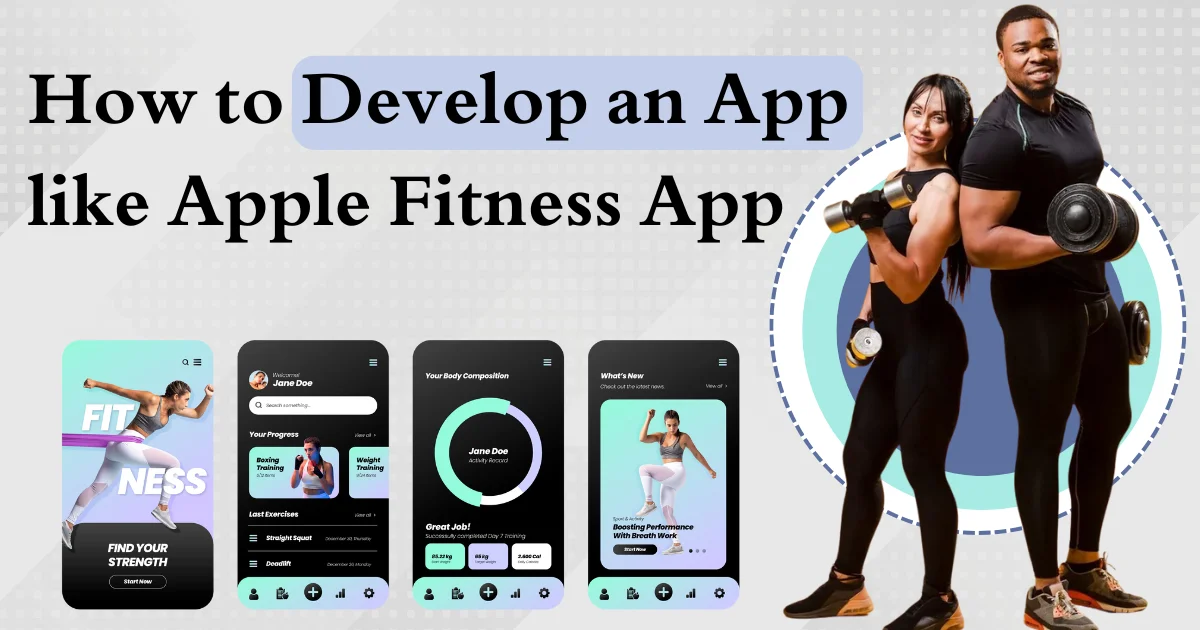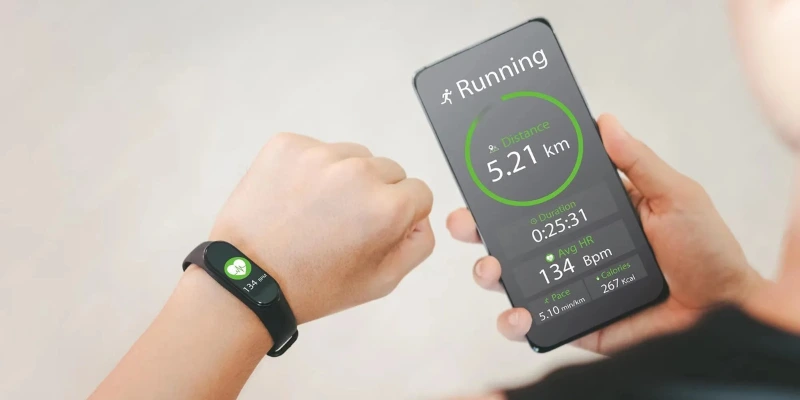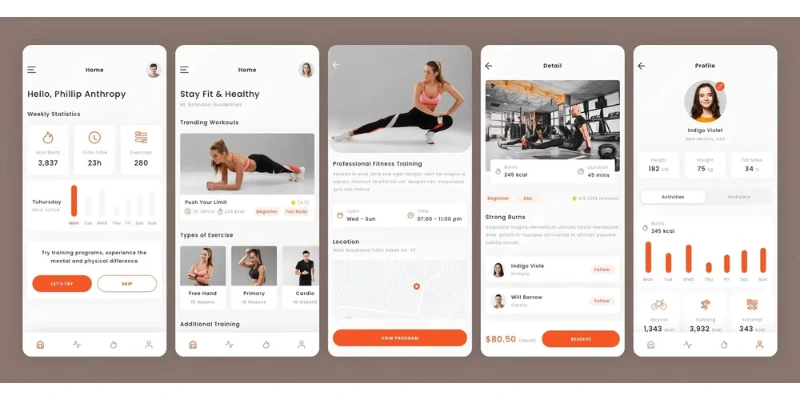Sales Team
Project quotes, partnerships, implementation

What if you could build a fitness experience so motivating that users feel excited every time their smartwatch buzzes? That’s exactly the magic behind the Apple Fitness App, a platform millions open daily to close their rings, track progress, and stay accountable. With the explosive rise of wearables, especially the Apple Watch, the demand for smart, intuitive, and high-performance fitness apps continues to surge.
If you’re looking to develop a future-ready fitness app in 2026, understanding how the entire Apple Fitness ecosystem works is the foundation. This comprehensive guide explores everything from must-have features and technology stacks to user needs, UI/UX best practices, Apple Watch integration, and emerging trends, so you can build a platform that competes with the top fitness apps in the market.
Apple has transformed the digital fitness landscape by combining powerful hardware, intelligent software, and an exceptionally user-friendly interface. This seamless ecosystem makes Apple Watch fitness apps the preferred choice for millions of users worldwide. The dominance comes from a blend of features that continuously deliver value, including:
Live Tracking: Real-time monitoring of steps, heart rate, calories burned, distance covered, workout duration, pace, and other essential fitness metrics. Users trust these insights because they are accurate, instant, and easy to understand.
Motivation & Accountability: Activity rings, monthly challenges, achievement badges, personalized coaching, and streaks keep users committed. These gamified elements make fitness fun and push users to stay consistent.
Deep Integration: Apple Watch fitness apps sync effortlessly with the iPhone, iPad, and HealthKit. This ensures data accuracy, smooth performance, and a unified fitness dashboard that enhances the user journey.
Simplicity & Usability: Clean visuals, intuitive layouts, and easy-to-follow progress charts help users stay focused on their goals without feeling overwhelmed.
With the growing popularity of the Apple Fitness App, the Planet Fitness Apple Watch app, and other top-performing platforms, the demand for innovative Apple Watch-compatible fitness apps continues to rise every year.
The global fitness app market is experiencing rapid growth, fueled by rising health awareness, smarter wearables, and the increasing demand for personalized wellness solutions. Today’s fitness app users are more informed, more engaged, and more results-driven than ever before. They expect platforms that deliver:
Accurate, Real-Time Tracking: Users want precise measurements of their steps, heart rate, calories burned, sleep patterns, and workout performance. Instant data helps them make better decisions during their fitness journey.
Personalized Workout Recommendations: Modern users expect customized routines based on their goals, fitness level, past performance, and health data. Tailored plans help them stay motivated and see measurable progress.
Social Connection & Healthy Competition: Leaderboards, friend challenges, shared goals, and community features keep users engaged. Social accountability has become a major retention driver in fitness apps.
Advanced Analytics & Progress Visualization: From weekly summaries to long-term performance trends, users want to see clear, data-driven insights that show how far they’ve come—and where they need to improve.
Seamless Wearable Syncing: Instant synchronization with devices like the Apple Watch is now a standard expectation. Users rely on smooth data flow across apps, devices, and platforms for a unified experience.
As fitness becomes increasingly data-centric, the Apple Watch fitness app ecosystem continues to expand at a rapid pace. With user expectations rising and wearable adoption at an all-time high, 2026 is an ideal time for businesses to enter or scale within this thriving industry.

Building a competitive fitness platform requires understanding what makes the Apple Fitness App and other top-performing Apple Watch fitness apps so effective. Below is an informative breakdown of the essential features that drive user engagement, retention, and long-term success.
User personalization sits at the core of every successful fitness app. Allow users to set goals based on weight, activity levels, steps, heart rate, or overall wellness. When users can tailor their fitness journey, engagement increases naturally. Personalized recommendations and goal tracking create a more meaningful and motivating experience.
Accurate tracking capabilities are non-negotiable. Your app should be able to measure:
Steps
Heart rate
Calories burned
Workout types
Active minutes
The app must support both Apple Watch users and non-watch users. This is especially important for scenarios where the fitness app is not tracking steps without an Apple Watch, ensuring your product caters to all user types and avoids common syncing limitations.
Artificial intelligence elevates the user journey by delivering smart, personalized guidance. AI can enhance:
Workout suggestions based on user goals
Intensity adjustments during training
Daily goal recalibration
Long-term performance trend analysis
These dynamic adjustments help users stay consistent and improve steadily over time.
Users want more than numbers—they want clarity. A powerful dashboard should provide insights into:
Sleep (if data is synced)
Steps
Activity rings
Calories burned
Heart rate patterns and variations
This level of detail mirrors the “Apple Fitness App explained” experience, helping users understand their progress and overall wellness at a glance.
Gamification is one of the strongest drivers of app engagement. Features like leaderboards, achievement badges, streaks, and community challenges keep users motivated and make fitness enjoyable. This is a key reason why the best Apple Watch fitness apps outperform ordinary trackers.
A holistic fitness app goes beyond workouts. Include tools for:
Hydration tracking
Calorie and macro intake logging
Mindfulness and mental wellness exercises
Stress monitoring (if synced with wearable data)
This supports a complete health ecosystem rather than just workout tracking.
Users appreciate timely nudges that help them stay active and committed. Motivational quotes, stand reminders, movement alerts, goal updates, and wellness tips make the experience more supportive and engaging throughout the day.
A robust fitness platform must integrate smoothly with external apps and devices, such as:
Gym and training apps
Meal and nutrition trackers
Smart health devices (weighing scales, heart monitors, etc.)
Supporting popular platforms—including apps like the Planet Fitness Apple Watch App—greatly increases your app’s versatility and overall value.

Building a fitness app for Apple Watch requires careful planning and a clear understanding of user needs. With millions relying on apps like the Apple Fitness App for step tracking, workouts, and health monitoring, creating a reliable, engaging, and personalized app is key. The process involves research, design, development, testing, and ongoing updates to ensure your app stands out in the competitive fitness market. Here’s a simple step-by-step guide to help you get started:
Start by understanding what users really need. Look at common problems such as “Apple Fitness App not tracking steps,” “fitness app not syncing with Apple Watch,” and “fitness app not tracking steps without Apple Watch.” These issues show where existing apps fail. By studying user reviews, market trends, and competitor weaknesses, you can build a fitness app that solves real problems and attracts more users.
Next, create a simple version of your app, called an MVP (Minimum Viable Product). This version should include only the must-have features like basic activity tracking, simple workouts, and progress rings. An MVP helps you test your idea quickly and get feedback before spending too much time or money.
For fitness apps in 2026, focusing on iOS and Apple Watch is the best choice. Apple devices offer strong sensors, smooth performance, and a huge user base. By building your app for the Apple ecosystem, you deliver a better experience and attract more fitness-focused users.
Good design is important for fitness apps. Your screens should be clean, easy to read, and simple to navigate. Avoid clutter and confusing layouts. Make sure your design works perfectly on the small Apple Watch screen so users can check their data quickly while working out.
Your app needs a strong backend to store data, manage users, and keep everything running smoothly. Choose a secure and scalable database, and create fast APIs to handle real-time fitness data. A solid backend ensures your app stays reliable even as the number of users grows.
Connecting your app with Apple HealthKit is essential. HealthKit lets your app access real-time Apple Watch data like heart rate, steps, calories, and sleep. This integration helps you provide accurate tracking and smooth syncing, which users expect from a top-quality fitness app.
Add AI features to make your app smarter. AI can suggest workouts, adjust difficulty levels, track performance trends, and predict daily goals. These personalized recommendations make your fitness app more engaging and help users stay motivated.
Before launching, test your app carefully. Check step tracking accuracy, Apple Watch syncing, Bluetooth connections, and workout performance. Test the app in real workout situations to ensure everything works perfectly, even when users are moving fast or sweating.
Prepare for launch by creating strong App Store content. Use keywords like “best fitness app for Apple Watch” to improve visibility. Add eye-catching screenshots, a clear app description, and a short demo video. Promote your app through ads, social media, and influencer campaigns to attract users.
After launching, keep improving your app. Release updates, fix bugs, add new features, and stay compatible with the latest Apple WatchOS. Listen to user feedback and make constant improvements. Regular updates keep your fitness app competitive and help you grow your user base.
Selecting the right technology stack is crucial for developing a reliable and high-performance Apple Watch fitness app.
Frontend: Use Swift and SwiftUI to build smooth, responsive interfaces for iPhone and Apple Watch. Leveraging WatchOS frameworks ensures your app takes full advantage of Apple Watch features like complications, notifications, and activity rings.
Backend: Use Node.js or Python for scalable, fast server-side development. Pair this with cloud platforms such as AWS, Firebase, or Google Cloud to handle real-time syncing, user management, and app scalability efficiently.
Database: Store user data securely using MySQL, PostgreSQL, or MongoDB, depending on your app’s requirements. Databases should handle large volumes of health metrics, workouts, and personalized recommendations.
APIs: Integrate HealthKit to access Apple Watch health data, use workout APIs for activity tracking, and include Notifications API to send timely reminders, alerts, and motivational messages.
AI Tools: Tools like TensorFlow and CoreML can enable AI-powered features such as personalized workout recommendations, predictive goal setting, and adaptive performance insights.
User experience (UX) is critical for fitness apps, especially when users interact with small Apple Watch screens. Focus on:
Simple, flat designs that highlight important metrics
Minimal buttons to avoid clutter
Large, readable numbers for steps, calories, and heart rate
High-contrast color palettes for quick visibility
Your UI should work seamlessly on both the Apple Watch and the iPhone companion app, ensuring users can easily track their progress and stay motivated throughout the day.
Apple Watch integration and HealthKit support are the backbone of any successful fitness app. Your app should support:
Automatic syncing between the watch and iPhone
Offline tracking so workouts are recorded without internet
Background data collection for continuous monitoring
Instant Bluetooth communication for real-time updates
By addressing common complaints like “fitness app not syncing with Apple Watch” or “Apple Fitness App not tracking steps”, your app can deliver a reliable and seamless experience that users trust.

AI can transform a fitness app from a simple tracker into a smart personal coach. Key AI-powered features include:
Personalized workout plans based on fitness level, goals, and past performance
Predictive goal setting that adjusts targets to keep users motivated
Smart reminders and alerts to encourage consistent activity
Body adaptation and recovery insights to prevent injury and optimize training
Apps with AI-driven personalization often become the best Apple Watch fitness apps because they keep users engaged and help them achieve measurable results.
Fitness apps handle sensitive health data, so protecting user privacy is non-negotiable. Ensure:
Data encryption for storage and transmission
Compliance with GDPR and HIPAA regulations
Secure cloud backups to prevent data loss
Role-based access to control sensitive information
Regular security audits to identify and fix vulnerabilities
A strong focus on security and compliance builds user trust and ensures your app is safe for health data tracking.
Testing: Comprehensive testing ensures your app works flawlessly. Test for device compatibility, Apple Watch syncing, HealthKit authorization, and accuracy in calorie, step, and heart rate tracking. Also, check UI responsiveness and performance under real workout conditions.
Launch: Optimize your App Store listing with SEO-friendly keywords such as “Apple Watch fitness app”, “best fitness app for Apple Watch”, and “best fitness Apple Watch apps”. Include clear descriptions, demo videos, and screenshots to attract users and boost downloads.
Maintenance: Regular updates are key to retaining users. Add new workouts, features, and integrations, fix bugs promptly, and ensure compatibility with the latest Apple WatchOS updates. Ongoing improvements keep your app competitive, reliable, and highly rated in the App Store.
Even the best Apple Fitness Apps can face technical challenges. Understanding common issues and how to fix them helps improve user experience and app reliability.
Issue 1: Apple Fitness App Not Tracking Steps
Solution: Check and re-enable Health permissions and motion settings on the iPhone and Apple Watch. Ensuring that step tracking and motion access are active resolves most issues related to inaccurate step counts.
Issue 2: Fitness App Not Syncing with Apple Watch
Solution: Reset Bluetooth connections, perform a force sync, and ensure both iPhone and Apple Watch are updated to the latest OS versions. This resolves syncing errors and restores accurate data transfer between devices.
Issue 3: Fitness App Not Tracking Steps Without Apple Watch
Solution: Enable manual step logging and consider integrating other wearable devices. This ensures users without an Apple Watch can still track their activity accurately.
Issue 4: Apple Fitness App Not Loading Workouts
Solution: Reconnect iCloud, re-sync workout modules, and verify internet connectivity. This resolves errors that prevent workouts from loading and ensures a smooth user experience.
The fitness app industry is evolving rapidly, with new technologies shaping how users train and track progress. Upcoming trends include:
AI-Powered Coaching: Apps will provide personalized guidance, adapting workouts to user performance in real-time.
Real-Time Motion Correction: Advanced sensors and AI will correct exercise form for safer and more effective workouts.
VR/AR Workout Environments: Immersive virtual training sessions will make workouts more engaging and motivating.
Advanced Wearable Analytics: Wearables will track deeper metrics like muscle activity, oxygen levels, and recovery rates.
Emotional & Stress-Based Workout Suggestions: Apps will adapt workouts based on user mood, stress levels, or mental state.
Smart Clothing Integration: Connected fitness apparel will provide additional biometric data to enhance training.
The next generation of Apple Watch fitness apps will be intelligent, adaptive, and fully integrated, combining wearable technology, AI, and immersive experiences to deliver a personalized fitness journey.
Creating a successful fitness app requires expertise in wearable technology, AI-driven personalization, and seamless user experience. SISGAIN offers end-to-end fitness app development services for Apple Watch, combining technical excellence with innovative design.
Our team specializes in:
Wearable Integration: Smooth Apple Watch and HealthKit syncing for accurate, real-time activity tracking.
AI & Personalization: Smart workout recommendations, predictive goal setting, and adaptive performance insights.
Intuitive UI/UX Design: Clean, engaging interfaces that work perfectly on small watch screens and companion iPhone apps.
Scalable Architecture: Secure, reliable, and future-ready backend systems to handle growing user data.
With SISGAIN, you can develop a high-performance, user-friendly fitness app that engages users, motivates them to reach their goals, and stands out in the competitive Apple Watch ecosystem.
Building an app like Apple Fitness in 2026 requires combining technology, creativity, user psychology, and deep integration with the Apple ecosystem. With the right features, smooth syncing, AI-driven personalization, and strong UI/UX, your app can easily compete with the best Apple Watch fitness apps and deliver a transformative experience for users. SISGAIN helps turn this vision into reality with high-quality development and innovation.
Project quotes, partnerships, implementation
Open roles, referrals, campus hiring